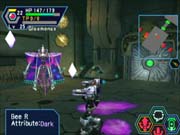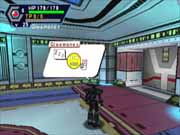Creating a new installment in a classic line of games is an extremely tricky endeavor. The developer must balance the game in an attempt to please those who remember the old games, as well as attract new players who don't know a thing about any of the series' previous installments. Phantasy Star Online is an extremely ambitious game, and while it may not be tied closely enough to the rest of the series to please its longtime fans right out of the box, the sheer fun of forming a party and playing online more than makes up for this, as well as most of the game's other deficiencies.
To escape your dying planet, you and your fellow citizens are being launched into space in two gigantic citylike spacecraft. Pioneer 1 scouts ahead to look for a new home, while you, along with most of your world's population, wait on board Pioneer 2. Eventually, Pioneer 1 sets up shop on a planet called Ragol and sends word that Ragol is a perfect new home. But when Pioneer 2 arrives and establishes communication with Pioneer 1, a giant mysterious explosion rocks the surface of Ragol, annihilating the colony. It's up to you, as a hunter in the employ of your government, to find out what happened to Pioneer 1.

While the rest of the Phantasy Star series is a collection of fairly standard RPGs, PSO takes an entirely different route. PSO takes most of its cues from Diablo, running in real time and relying on your ability to hit the attack buttons in a rhythmic fashion to perform basic attack combos. There are three different character classes, and three different races to choose from. The ranger is the easiest character for beginners, as the class is quite proficient with ranged weapons. Forces are your typical magic users--fairly weak with physical attacks, but once leveled up, they can rely on magic techniques to survive. Warriors are best with sword-type weapons. The three different races--human, numan, and android--come into play during character creation as well, altering a character's starting attributes. Furthermore, androids are unable to cast techniques at all. The character creation also extends to your appearance. You can select from different heads, body types, colors, and sizes.
The game's combat is simple real-time fighting. You simply walk up to enemies or aim your weapon and hit the proper attack button to strike. Each weapon has at least two attack strengths, and some have a third with additional effects, such as draining hit points or technique points. You have six fully configurable buttons at your disposal, which is plenty for warriors and rangers, but forces will find themselves heading to the menu screens way too often to cast various techniques. On the planet, you walk from room to room, defeating enemies as they spawn in your current location. More often than not, you'll need to defeat all of a room's enemies to proceed. The enemies are well designed, though most of them aren't very smart, choosing to simply walk or float directly at you until they're close enough to attack. Also, enemies can't leave their room, meaning you can go hide on the other side of an open door whenever things get too hectic. Leaving a room causes the enemies to walk back to their starting positions, though they'll all keep their current hit points. So the major tactic in the later levels is walking into a room, shooting monsters until they get close, leaving the room until they get away from the door, reentering, and so on.
The item set is fairly standard RPG fare, ranging from weapons to armor and shields. The new twist here is the addition of a MAG. MAGs are little floating companions who follow you around. MAGs grow when you feed them various items, and they can be fed three items for every five or so minutes of gameplay. As MAGs grow, they change shape and learn spells of their own called photon blasts. As you fight or take damage, a meter charges up. When the meter reaches 100, you can call upon your MAG to unleash a photon blast. Different character classes get different MAGs and thus different photon blasts.

Much of the game's offline component focuses on side quests, which you choose from a menu in the hunter's guild. The quests are an excellent way to keep busy while you fight to gain experience points, but they're extremely inane and have absolutely nothing to do with the game's overall story, which only checks in here and there in the form of messages left on the planet by Rico Tyrell, one of the survivors of the Pioneer 1 explosion. The quests are very modular, each using the same set of planet areas in a different way. For instance, on a quest to find a scientist disguised as a monster, all the monsters in the forest are Rag Rappys. Other quests rearrange your starting position and which doors open when, but the actual terrain is the same every time. So, if you're bent on finishing each quest, expect to attack each of the game's worlds numerous times. Beating the area's boss opens up the next area and provides a new set of side quests, should you be in the mood. Expect to tire of the quests rather quickly, as they really drag down the game's offline component. While you can skip the quests and fight right to the boss, you may find yourself ill equipped to face the area boss if you haven't spent enough time leveling up. Also, some of the characters are a little weaker to start off with, making playing alone as a force or warrior more difficult than sticking to the ranger's guns and rifles, which allow you to pick off foes from a safe distance. Considering most of the enemies simply lumber in your direction at a fairly slow pace, it's easy to waste foes before they even get close enough to land a blow. Even when dealing with harder enemies, it's easy to run circles around a room full of foes, bunching them into a tightly packed group, ripe for the business end of your pistol, sword, or area-effect technique.

So, sure, the offline game gets tedious fast. But the game isn't called Phantasy Star Offline. The main draw of the game is the ability to get online, hook up with three other players in one of the game's many lobbies, and take on the planet Ragol as a team. Obviously, this is where the game shines. The basics of the game remain unchanged, but with four players on the planet surface, different tactics come into play, especially during boss fights. Here, the rangers can hang back with ranged weapons, while the warriors remain up close and personal to deal out some high damage attacks. The force players can occasionally strike out with attack techniques while they ensure that the other three members of the party are in good health at all times. Teamwork can also pay off outside of boss fights, as the game really throws a lot of enemies at your party, making it easy for some players to get surrounded. There are still a few side quests to embark on, and it's likely that Sega will add more online-only quests as time goes on. Unfortunately, upon completing any one of the quests, your game is ended and your party is tossed back into the lobby. Also, the lack of any player-vs.-player action may solve the problem of high-level characters tormenting weaker players, but it would have been nice to see some sort of challenge mode. Finally, the game lacks any secure way to trade items between players. You simply have to drop your items on the ground to let someone else take them, opening yourself up to unscrupulous thieves. It should be noted that the game very rarely displayed any signs of lag, even when playing with players from Japan and Europe. It should be noted that, officially, PSO doesn't support the broadband adapter. However, there is a bit of unofficial support in there, so some users may be able to connect using Sega's newly released broadband adapter, depending on their network configuration. We were unable to get it running on any of the networks we tried.
In both modes, the game suffers from some pretty atrocious camera work. The L button is used to center the third-person Tomb Raider-like camera angle directly behind your player, and you'll find yourself having to hit it constantly just to see where you're going. While the slow-to-adjust camera lets you do things like run away from a foe while still keeping an eye on it, too often you'll find yourself simply staring at the radar screen in the corner of your screen instead of the main action. Compounding the game's camera woes is an almost total lack of lock-on targeting. With a few fast-moving enemies, your character will auto-track, but more often than not, you're stuck trying to line up a clean shot on a foe, wasting valuable seconds of firing time. While the problem is most noticeable when using ranged weapons, it rears its ugly head up close, as well. After getting used to the camera and aiming flaws, the control becomes second nature and only becomes an issue when you're trapped in a corner.

Communicating with players is extremely easy, especially when you consider that the game can be played in five different languages. Aside from merely typing in messages with either your DC controller or the DC keyboard, you can cobble together phrases and questions from the game's built-in list of preset comments, which are automatically translated into all of the game's languages. The game also lets you speak via symbol chat, which comes preset with smiles, frowns, calls for help, and more. You can also create your own symbols out of a large array of preset parts. Aside from in-game messages, you can give and receive guild cards. Once you've obtained another user's guild card, you can search for him or her online, as well as send and receive small mail messages.
Graphically, PSO is a nice, colorful game, with good animation and decent, albeit repetitive, textures. For the most part, the game runs at a nice, high speed. However, get four players in a large room full of monsters, and the frame rate takes a nasty nosedive. Thankfully, this doesn't happen all that often. Also, the game has quite a bit of pop-up, though it only affects items, crates, and other world objects--you'll still be able to see the entire room, but something important, like a teleporter, might not show up until you get pretty close to it. The music and sound effects are pretty good, though the music can get repetitive after spending a few hours in the same location. As previously stated, PSO is extremely light on story. Also, it doesn't bear much resemblance to the rest of the games in the series, though it does manage to tie the game's final goal into the rest of the series.
PSO has its share of problems--problems that could have been avoided had the game's developers looked a little more closely at similar games, such as Diablo II for the PC. But in the end, even with its shallow storyline and camera issues, Phantasy Star Online simply manages to be a whole lot of fun. Enough fun, in fact, to overshadow most of the game's flaws. However, don't even waste your time with PSO unless you're planning on heavily favoring the game's online mode.